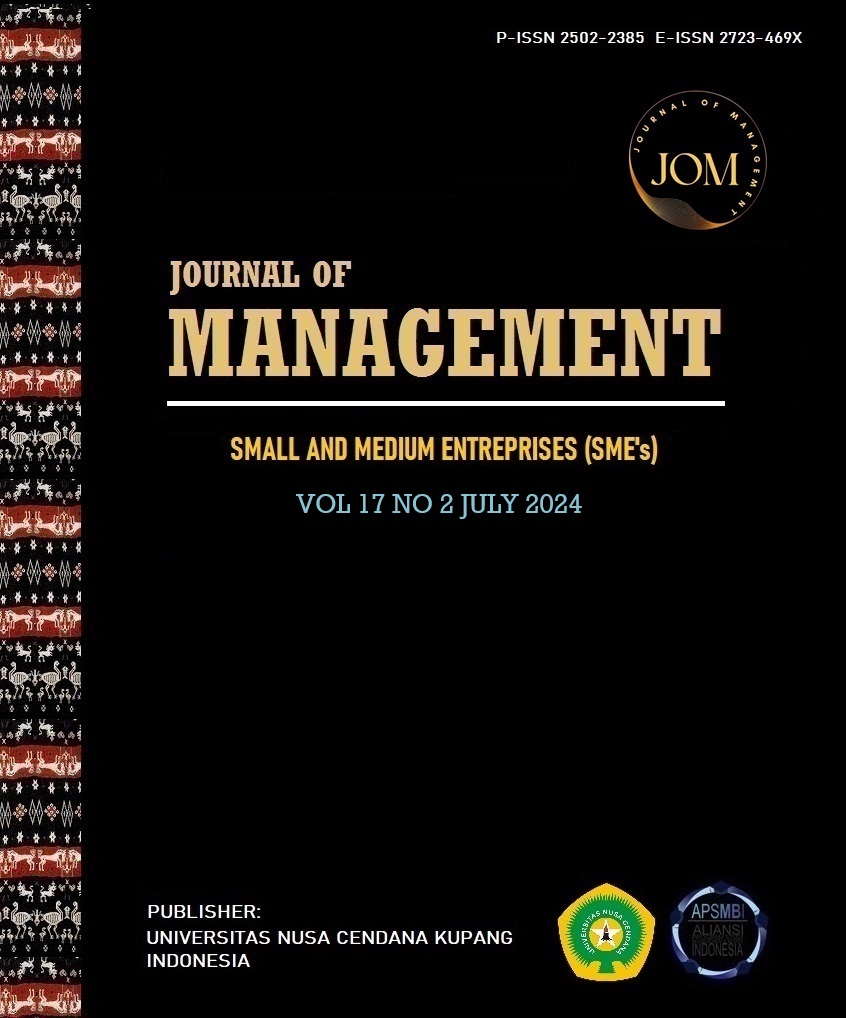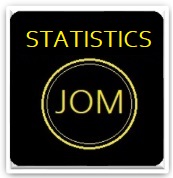THE GLOBAL WORKFORCE: CHALLENGES AND OPPORTUNITIES IN INTERNATIONAL HUMAN RESOURCE MANAGEMENT
Abstract
This article investigates the challenges and opportunities in international human resource management (HRM) in Indonesia and its strategies. This qualitative study describes how companies manage HRM across various dimensions and addresses cultural differences, employment policies, and international recruitment factors. Data were obtained from secondary sources such as journals, books, and relevant industry reports. Challenges include cultural aspects, distance management, and international talent selection, while opportunities include enhancing competitive advantages and employee productivity. Strategies to address these challenges involve cross-cultural understanding, training, global communication technology, and policies accommodating differences in regulations between countries. Collaboration with international HR consultants is also recommended. With a holistic approach, international HRM can build an efficient and diverse global workforce, ensuring the success of global operations.
Keywords: Global Workforce; International Human Resource Management; Challenge; Opportunities
Downloads
References
Bhavin, M., Tanwar, S., Sharma, N., Tyagi, S., & Kumar, N. (2021). Blockchain and quantum blind signature-based hybrid scheme for healthcare 5.0 applications. Journal of Information Security and Applications, 56(December 2020), 102673. https://doi.org/10.1016/j.jisa.2020.102673
Buganová, K., & Šimíčková, J. (2019). Risk management in traditional and agile project management. Transportation Research Procedia, 40, 986–993. https://doi.org/10.1016/j.trpro.2019.07.138
Chatterjee, S., Chaudhuri, R., Vrontis, D., Thrassou, A., & Ghosh, S. K. (2021). Adoption of artificial intelligence-integrated CRM systems in agile organizations in India. Technological Forecasting and Social Change, 168(November 2020), 120783. https://doi.org/10.1016/j.techfore.2021.120783
El Nsour, J. A. (2021). Investigating the impact of organizational agility on the competitive advantage. Journal of Governance and Regulation, 10(1), 153–157. https://doi.org/10.22495/JGRV10I1ART14
Farzaneh, M., Ghasemzadeh, P., Nazari, J. A., & Mehralian, G. (2020). Contributory role of dynamic capabilities in the relationship between organizational learning and innovation performance. European Journal of Innovation Management, 24(3), 655–676. https://doi.org/10.1108/EJIM-12-2019-0355
Fukuda, K. (2020). Science, technology and innovation ecosystem transformation toward society 5.0. International Journal of Production Economics, 220(April 2019), 107460. https://doi.org/10.1016/j.ijpe.2019.07.033
Gergin, Z., Çolak, E., Kayalar, M., & Yavaşoğlu, C. D. (2022). A New Organizational Agility Assessment Approach Applied in the Logistics Industry. Journal of Business Research - Turk, 14(2), 1129–1147. https://doi.org/10.20491/isarder.2022.1431
Gurbuz, F. G., & Hatunoglu, S. B. (2022). Assessment of Organizational Agility: Adaptation and Validation of the Scale for Application in Turkey. Pressacademia, 9, 27–37. https://doi.org/10.17261/pressacademia.2022.1546
Hernaus, T., Konforta, M., & Sitar, A. S. (2020). A multi‐informant assessment of organizational agility maturity: An exploratory case analysis. Dynamic Relationships Management Journal, 9(2), 85–104.
https://doi.org/10.17708/DRMJ.2020.v09n02a05
Holbeche, L. (2019). Designing sustainably agile and resilient organizations. Systems Research and Behavioral Science, 36(5), 668–677.
https://doi.org/10.1002/sres.2624
Huang, S., Wang, B., Li, X., Zheng, P., Mourtzis, D., & Wang, L. (2022). Industry 5.0 and Society 5.0—Comparison, complementation and co-evolution. Journal of Manufacturing Systems, 64(July), 424–428.
https://doi.org/10.1016/j.jmsy.2022.07.010
Islam, A., Wahab, S. A., & Latiff, A. S. A. (2022). Annexing a Smart Sustainable Business Growth Model for Small and Medium Enterprises (SMEs). World Journal of Entrepreneurship, Management and Sustainable Development, 18(2), 185–209. https://doi.org/10.47556/J.WJEMSD.18.2.2022.2
Kahl, J., de Klerk, S., & Ogulin, R. (2022). Agile strategies for middle managers. Management Decision, 60(1), 146–166. https://doi.org/10.1108/MD-07-2020-0889
Khan, H. (2020). Is marketing agility important for emerging market firms in advanced markets? International Business Review, 29(5), 101733.
https://doi.org/10.1016/j.ibusrev.2020.101733
Liu, Y., Chung, H. F. L., Zhang, Z., & Wu, M. (2023). When and how digital platforms empower professional services firms: an agility perspective. Journal of Service Theory and Practice, 33(2), 149–168. https://doi.org/10.1108/JSTP-04-2022-0092
Margherita, A., Sharifi, H., & Caforio, A. (2021). A conceptual framework of strategy, action and performance dimensions of organisational agility development. Technology Analysis and Strategic Management, 33(7), 829–842.
https://doi.org/10.1080/09537325.2020.1849611
Mirabeau, L., & Maguire, S. (2013). From Autonomous Strategic Behavior To Emergent Strategy Author ( S ): Laurent Mirabeau And Steve Maguire Stable Url : Https://Www.Jstor.Org/Stable/24037306 References Linked References Are Available On Jstor For This Article : From Autonomous Strategic Be. 35(8), 1202–1229.
Nagahara, M. (2019). A Research Project of Society 5.0 in Kitakyushu, Japan. CCTA 2019 - 3rd IEEE Conference on Control Technology and Applications, 803–804. https://doi.org/10.1109/CCTA.2019.8920449
Nolte, A., Pe-Than, E. P. P., Affia, A. O., Chaihirunkarn, C., Filippova, A., Kalyanasundaram, A., Angarita, M. A. M., Trainer, E., & Herbsleb, J. D. (2020). How to organize a hackathon -- A planning kit. http://arxiv.org/abs/2008.08025
Oliva, F. L., Couto, M. H. G., Santos, R. F., & Bresciani, S. (2019). The integration between knowledge management and dynamic capabilities in agile organizations. Management Decision, 57(8), 1960–1979. https://doi.org/10.1108/MD-06-2018-0670
Pastrana, P, M. A., Erazo, H. A. O., & Lozada, C. A. C. (2022). Teaching Guide for Beginnings in DevOps and Continuous Delivery in AWS Focused on the Society 5.0 Skillset. Revista Iberoamericana de Tecnologias Del Aprendizaje, 17(4), 358–370. https://doi.org/10.1109/RITA.2022.3217172
Polat, L., & Erkollar, A. (2021). Industry 4.0 vs. Society 5.0. In Lecture Notes in Mechanical Engineering. https://doi.org/10.1007/978-3-030-62784-3_28
Ridwandono, D., & Subriadi, A. P. (2019). IT and organizational agility: A critical literature review. Procedia Computer Science, 161, 151–159.
https://doi.org/10.1016/j.procs.2019.11.110
Schuh, G., Prote, J. P., Gützlaff, A., Ays, J., & Donner, A. (2019). Fixed cost management as an enabler for agile manufacturing networks. Procedia Manufacturing, 39(2019), 625–634. https://doi.org/10.1016/j.promfg.2020.01.435
Skyrius, R., & Valentukevičė, J. (2020). Business Intelligence Agility, Informing Agility and Organizational Agility: Research Agenda. Informacijos Mokslai, 90, 8–25. https://doi.org/10.15388/Im.2020.90.47
Spagnoletti, P., Kazemargi, N., & Prencipe, A. (2022). Agile Practices and Organizational Agility in Software Ecosystems. IEEE Transactions on Engineering Management, 69(6), 3604–3617. https://doi.org/10.1109/TEM.2021.3110105
Strode, D. E., Sharp, H., Barroca, L., Gregory, P., & Taylor, K. (2022). Tensions in Organizations Transforming to Agility. IEEE Transactions on Engineering Management, 69(6), 3572–3583. https://doi.org/10.1109/TEM.2022.3160415
Theodore, W., Kasali, R., Balqiah, T. E., & Sudhartio, L. (2022). The effects of task environment and organizational agility on perceived managerial discretion and strategy implementation in a pharmaceutical company. International Journal of Pharmaceutical and Healthcare Marketing, 16(2), 204–221.
https://doi.org/10.1108/IJPHM-11-2021-0116
Walter, A. T. (2021). Organizational agility: ill-defined and somewhat confusing? A systematic literature review and conceptualization. In Management Review Quarterly (Vol. 71, Issue 2). Springer International Publishing.
https://doi.org/10.1007/s11301-020-00186-6
Wicaksana, S. A., & Isfania, R. (2022). Building Organizational Agility Through Knowledge Sharing and Organizational Culture in Non-Departmental Government Agencies. Jurnal Aplikasi Bisnis Dan Manajemen, 8(3), 749–757.
https://doi.org/10.17358/jabm.8.3.749
Zhen, J., Cao, C., Qiu, H., & Xie, Z. (2021). Impact of organizational inertia on organizational agility: the role of IT ambidexterity. Information Technology and Management, 22(1), 53–65. https://doi.org/10.1007/s10799-021-00324-w

 Eliyunus Waruwu(1*)
Eliyunus Waruwu(1*)



